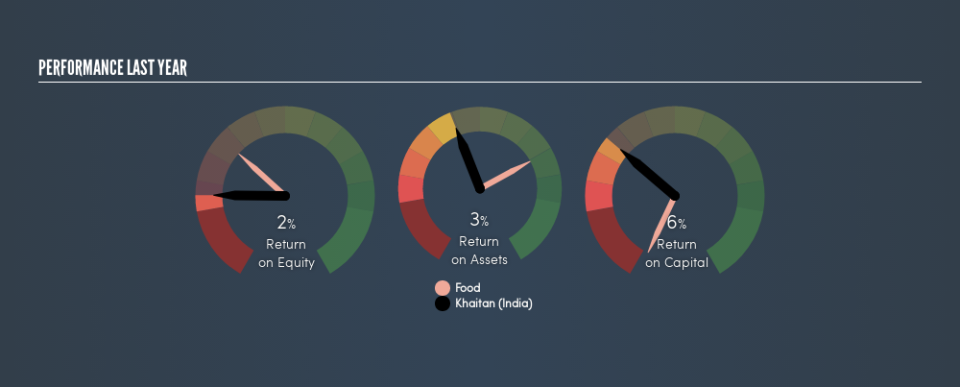How Do Khaitan (India) Limited’s (NSE:KHAITANLTD) Returns On Capital Compare To Peers?

Today we'll evaluate Khaitan (India) Limited (NSE:KHAITANLTD) to determine whether it could have potential as an investment idea. Specifically, we're going to calculate its Return On Capital Employed (ROCE), in the hopes of getting some insight into the business.
First, we'll go over how we calculate ROCE. Second, we'll look at its ROCE compared to similar companies. And finally, we'll look at how its current liabilities are impacting its ROCE.
What is Return On Capital Employed (ROCE)?
ROCE measures the amount of pre-tax profits a company can generate from the capital employed in its business. All else being equal, a better business will have a higher ROCE. Ultimately, it is a useful but imperfect metric. Renowned investment researcher Michael Mauboussin has suggested that a high ROCE can indicate that 'one dollar invested in the company generates value of more than one dollar'.
So, How Do We Calculate ROCE?
Analysts use this formula to calculate return on capital employed:
Return on Capital Employed = Earnings Before Interest and Tax (EBIT) ÷ (Total Assets - Current Liabilities)
Or for Khaitan (India):
0.061 = ₹33m ÷ (₹1.0b - ₹502m) (Based on the trailing twelve months to March 2019.)
Therefore, Khaitan (India) has an ROCE of 6.1%.
See our latest analysis for Khaitan (India)
Is Khaitan (India)'s ROCE Good?
One way to assess ROCE is to compare similar companies. We can see Khaitan (India)'s ROCE is meaningfully below the Food industry average of 12%. This could be seen as a negative, as it suggests some competitors may be employing their capital more efficiently. Putting aside Khaitan (India)'s performance relative to its industry, its ROCE in absolute terms is poor - considering the risk of owning stocks compared to government bonds. It is likely that there are more attractive prospects out there.
Khaitan (India) reported an ROCE of 6.1% -- better than 3 years ago, when the company didn't make a profit. That implies the business has been improving. You can see in the image below how Khaitan (India)'s ROCE compares to its industry. Click to see more on past growth.
When considering ROCE, bear in mind that it reflects the past and does not necessarily predict the future. ROCE can be misleading for companies in cyclical industries, with returns looking impressive during the boom times, but very weak during the busts. ROCE is, after all, simply a snap shot of a single year. How cyclical is Khaitan (India)? You can see for yourself by looking at this free graph of past earnings, revenue and cash flow.
How Khaitan (India)'s Current Liabilities Impact Its ROCE
Short term (or current) liabilities, are things like supplier invoices, overdrafts, or tax bills that need to be paid within 12 months. Due to the way the ROCE equation works, having large bills due in the near term can make it look as though a company has less capital employed, and thus a higher ROCE than usual. To counteract this, we check if a company has high current liabilities, relative to its total assets.
Khaitan (India) has total assets of ₹1.0b and current liabilities of ₹502m. Therefore its current liabilities are equivalent to approximately 48% of its total assets. In light of sufficient current liabilities to noticeably boost the ROCE, Khaitan (India)'s ROCE is concerning.
The Bottom Line On Khaitan (India)'s ROCE
So researching other companies may be a better use of your time. But note: make sure you look for a great company, not just the first idea you come across. So take a peek at this free list of interesting companies with strong recent earnings growth (and a P/E ratio below 20).
I will like Khaitan (India) better if I see some big insider buys. While we wait, check out this free list of growing companies with considerable, recent, insider buying.
We aim to bring you long-term focused research analysis driven by fundamental data. Note that our analysis may not factor in the latest price-sensitive company announcements or qualitative material.
If you spot an error that warrants correction, please contact the editor at editorial-team@simplywallst.com. This article by Simply Wall St is general in nature. It does not constitute a recommendation to buy or sell any stock, and does not take account of your objectives, or your financial situation. Simply Wall St has no position in the stocks mentioned. Thank you for reading.


